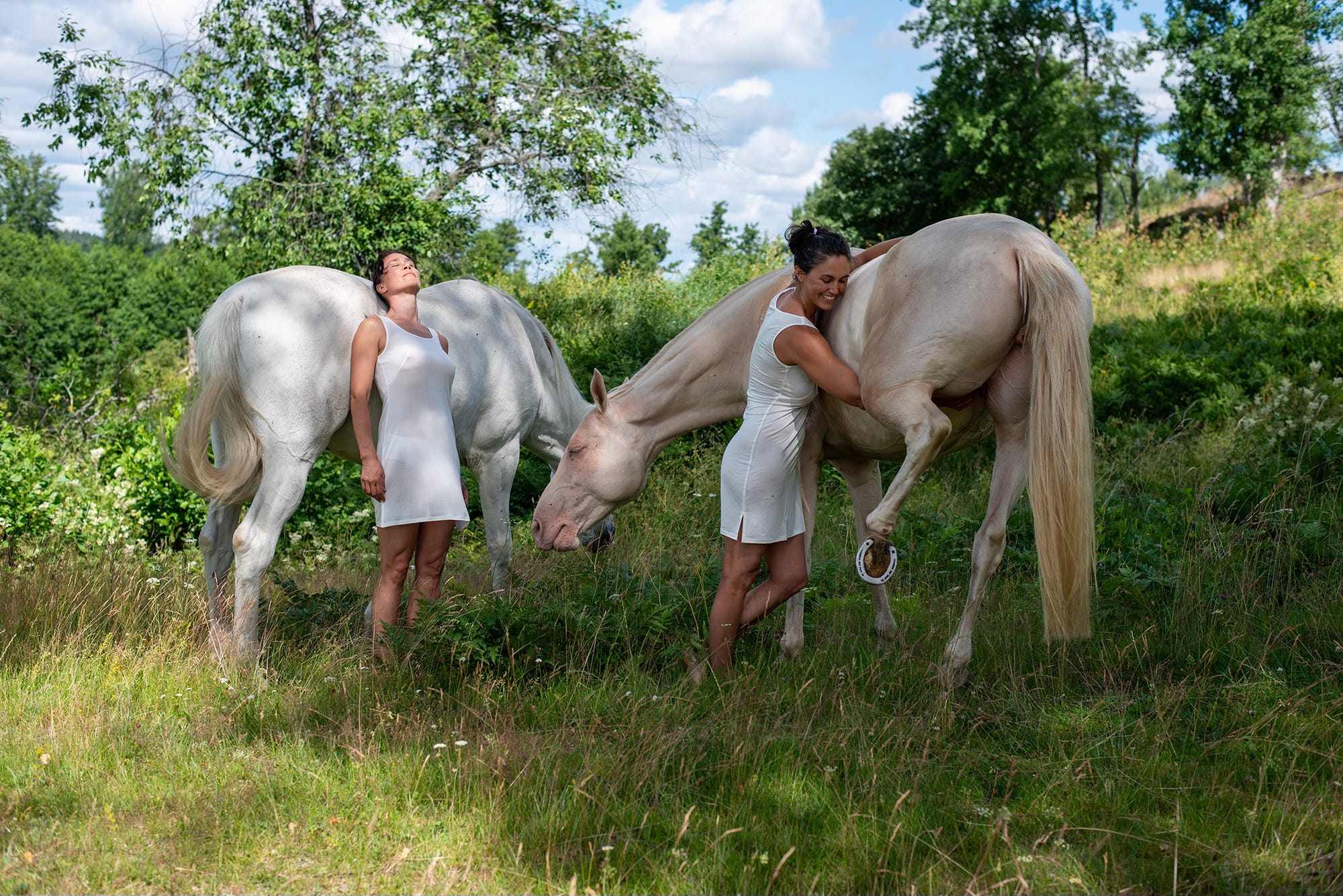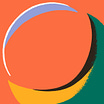Chimera Cyborg Creatures: An Ode to Our Dead Horses
Excerpt from the book The Horse, The Robot, and The Immeasurable
If you are a regular or have just discovered Tarantula: Authors and Art, welcome. This April we ended up having two inspirations, our guest writer Karin Victorin and artist Tove Kjellmark who previously collaborated on Tove’s project The Horse, The Robot, and The Immeasurable. Tove invited Karin into her studio to have a conversation about their love for horses as well as a topic often avoided - death. That conversation, along with her own personal story of her deep bond with horses, inspired Karin to write a heartfelt article Chimera Cyborg Creatures: An Ode to Our Dead Horses. We are lucky to have received permission to publish an excerpt. If a friend forwarded you this article, welcome; if you like it, share it or why not subscribe?
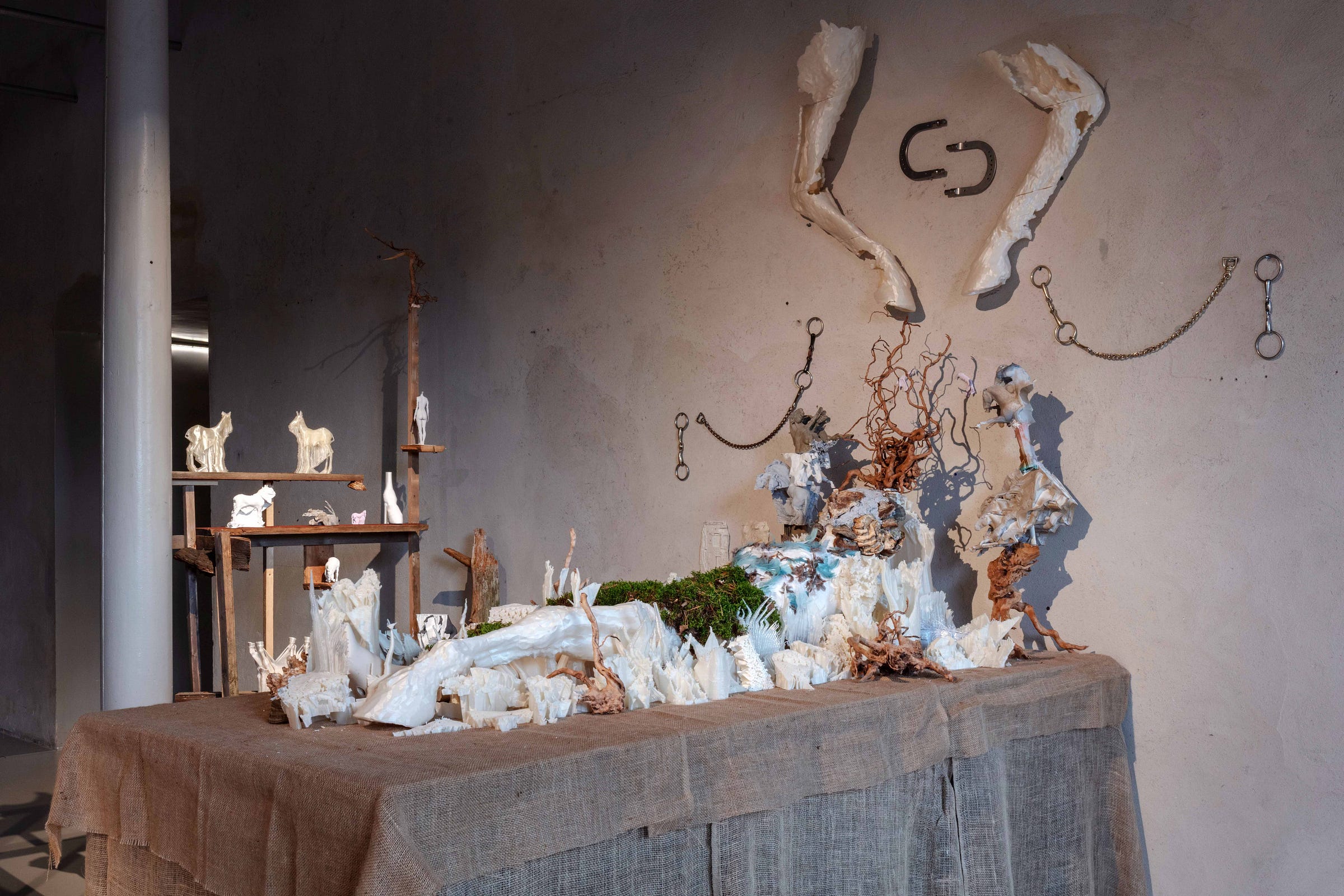
“There is something about the outside of the horse that is good for the inside of a man” -Winston Churchill
Sheba was the name of my first horse. She was a Connemara pony with a lively and challenging temperament, even frightening to some of the other kids that went to the riding camp where my sister and I found her, three years old, and hardly ridden. I wondered why my parents considered the purchase to be a good idea, but I guess it was partly because they finally gave into our nagging. From another perspective, taking care of Sheba was exactly what brought me back on my feet during a time of early puberty. Transitioning from a girl to a young woman was a struggle where I was caught in a liminal space between life and death. I refused the grown-up world, as I dolefully witnessed how my friends gave up play to spend the weekends going out drinking, many started smoking, and competed with looks to impress, and be part of the cool gang. In school, competition between girls generated individual performance anxiety in me. I dropped 30 kilos in 6 months and weighed only 38 kilos (176 cm tall). I had become a living ghost, lost in a liminal space between childhood and adulthood. I was in a state where I didn’t even dream at night – no energy could be wasted as survival instincts kicked in, using what little energy was left in me to keep my body functioning. The only thing that could bring me back to life was a horse and my parents desperately put all their hope into this solution.
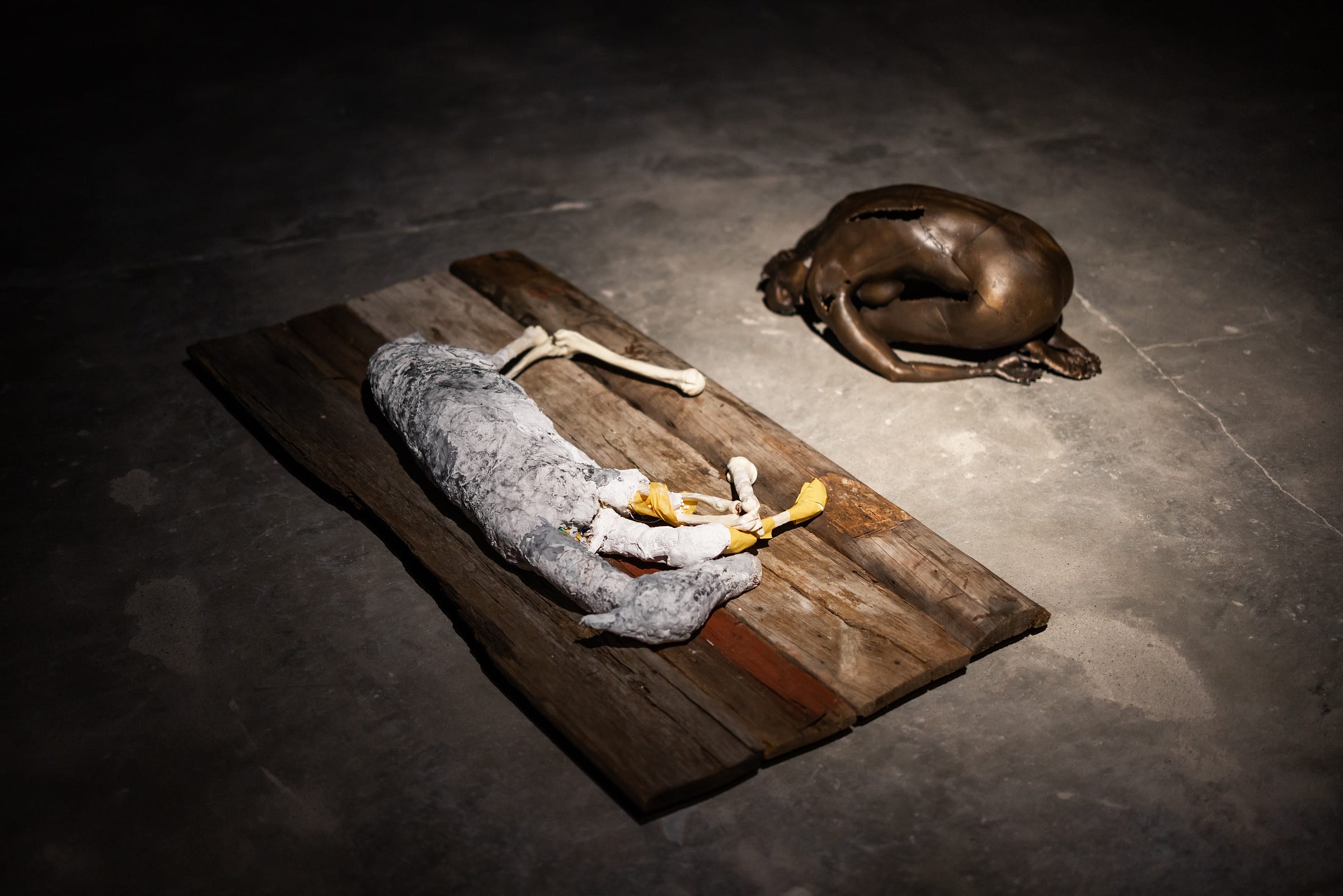
I have Sheba to thank for my life. In gratitude, I have devoted myself to helping sick horses and horses who would have died, had I not taken care of them. In my early twenties, I studied to become an equine-therapist. During this time, I bought my second horse, Yarraman. My grandmother had given all her grandchildren 10000kr each as an early inheritance that she wanted to hand out while she was still alive. I found Yarraman through an ad in Gula Tidningen. He had been abandoned by his owner and was standing alone in a small garden accompanied by a bunch of inbred German Shepherd dogs. He looked miserable, only three years old, and never ridden, yet there was an incredible spark and sign of strength in his eyes, as he looked me straight in the eye. I knew he asked me to rescue him, and the owner let me buy him for grandma’s 10000kr, a cheap price for a horse. Yarraman suffered from starving, mirroring my puberty trauma. In his case, the starvation came from severe dental issues that took years to treat, but eventually, he got better through dental treatments combined with acupuncture and herbs. The bond that grew between Yarraman and me is hard to describe in words. He was a half-bred (Akal-Teke/trotter), and we started training endurance, successfully leading up to elite level competitions. It was never winning that was the main ambition, but rather the opportunity to spend hours together along trailways, in nature. Endless time together, riding up to 140 km in one day, our horse/human body merged, becoming a chimera with invisible wings. With Yarraman, I did not have to use direct aids. All I had to do was think gallop, trot, or walk, and Yarraman would adjust to what we both found to be the best pace or speed so that we could last throughout the day and not be over 60 heartbeats per minute (BPM) in the obligatory veterinarian gates. It is worth noting that the heart of a horse is five times bigger than a human heart. According to quantitative studies that measure the emotional bond between horses and humans, horses have similar heart rate variability (HRV) to what humans have when they are in coherent and incoherent emotional states. Researcher Ellen Kaye Gehrke, explains how HRV dynamics are particularly sensitive to changes in emotional states. Different types of emotions can readily be distinguished by changes in heart rhythm patterns, which are independent of heart rate. Gehrke could prove that horses respond to human emotions. Her studies show that horses are highly sensitive beings and very adaptable to human feelings. We affect horses more than they affect us, but they have a great impact on us too. Since a horse's heart beats much slower than ours, it can feel very calming and grounding to be physically close to a horse. Tove and I continue to talk about how the horse tends to be a healing source when we feel stressed or out of balance. As teenagers, our horses served as a lifeline, putting us back in touch with ourselves. We have heard many stories from other friends and parents about how horses have helped them, or their loved ones, struggling with mental health issues, and emotional imbalances when nothing else seemed to work.
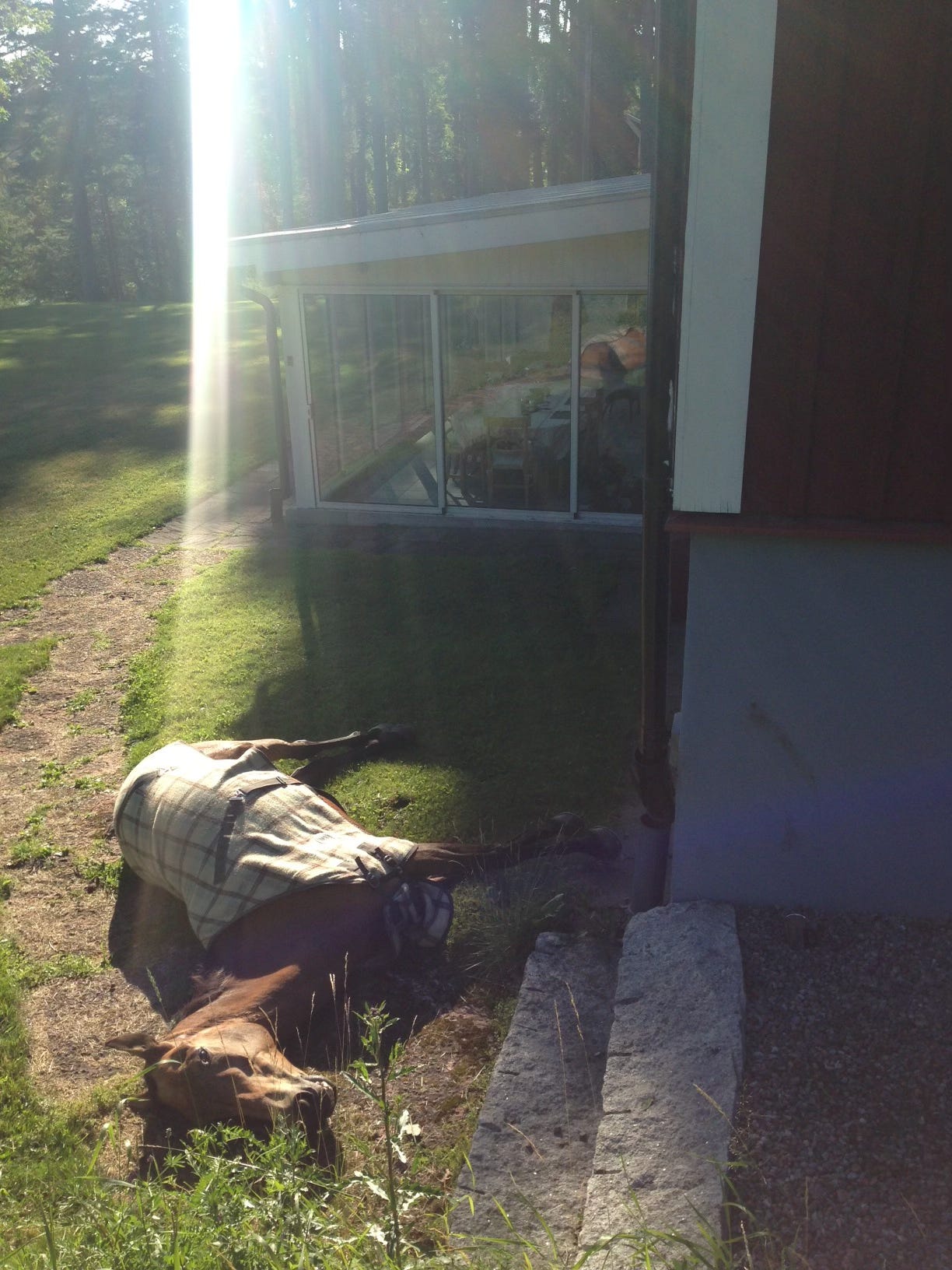
Tove continues to tell me the story of her first pony Sparvöga and how important the relationship to this horse was in her process of becoming a woman. Her sister inherited Sparvöga, and later she got a foal and lived a good life growing old. Tove had just given birth to her daughter Lea when it was time for Sparvöga to pass on. She brought her baby to the stable to say goodbye and doesn’t remember this as being a particularly sad farewell. Just like Tove, I had recently become a mother when Yarraman passed away. Years had passed and Yarraman was getting older. From the same Akhal Teke stud where Yarraman’s father was from, a young golden mare caught my eye and heart. Aisona became my third horse in line. In 2013, she gave birth to a breathtaking perlino-colored foal that Aisona pushed straight into my arms. When the foal opened her eyes, they were heavenly crystal blue. Her appearance was strikingly otherworldly. The foal was Setare, who plays a key role in Tove’s exhibition at Färgfabriken, in which Setare, with her transparent-colored and chimera-like otherworldly features, explores the empty art space. Yarraman, 19 at the time, was also present, standing in the stable when Setare was born. He was such a gentleman, as he kept a low profile the first couple of weeks in the field, keeping a distance to a very protective Aisona, and then slowly being accepted into co-parenting. Aisona and I had been pregnant together. I had given birth to a son four months earlier, and the beginning of summer was a joyous time spent together as a family of companion species. My three horses shared a spacious field with the farmer's cows. One day, when I arrived at the field, I noticed that something was wrong with Yarraman. He was holding his head low, and when I got closer, I could see he had a black eye and was panting. I managed to walk him up to the stable and called the vet. After years of competing endurance, I had built up a routine to measure his pulse and was devastated when I counted 130 beats per minute, which is extremely high for a horse. His resting heart rate was usually around 30-35 BPM. His temperature was close to normal, but I felt that his ears and lower limbs were unusually cold. Being an equine-therapist, I suspected that something was wrong with his circulation – but what was causing it? Poisoning? Injury with inner bleeding? The vet arrived and he tried to figure out what was wrong. He tested to see if it could be colic, but even though Yarraman didn’t eat or drink, or piss or shit, the vet could not understand what was causing the severe symptoms. Eventually, the vet had to leave. He gave Yarraman a shot of morphine, and with great concern, told me that there was not much to do since my horse was not in a state where he could be transported to a veterinarian's clinic. At this point, Tove asks me if Yarraman was still standing up. I tell her that he was, and we talk for a while about how horses stand up even if they are in severe condition of pain. Being flight animals, they are anatomically built and instinctively programmed to stand-up no matter what. That is why humans need to stay attentive to any signs of discomfort and disease in a horse.
During the evening, I did everything to help Yarraman to try to at least make him drink some water. As an endurance rider, I know all the tricks to get a horse to drink, but nothing worked. Yarraman was getting colder by the hour. His breathing was fast as if he were running a race, yet he had been completely still for hours. At 3 am, I had to go to bed and breastfeed my baby. I fell asleep and was woken up by my mother in the morning. She was crying while telling me how my father had gone down to the kitchen to make breakfast when he saw Yarraman lying flat on the ground in front of the large kitchen window. My thoughts started racing. How had he, high on morphine and very sick, managed to get out of the closed stable door? I ran down to the kitchen and found him lying there, with the first streaks of sunbeams lighting up his body. I gently sat down by his head, which bore marks of new scratches from opening the stall. As I looked into his eyes, I caught that familiar spark – it was brief, yet eternal – before it vanished. I am convinced that Yarraman waited for me, he might already have been physically dead according to human measures, but his spirit persisted.My conclusion is that Yarraman was so determined to find me that he did everything he could to get out of the stable. He had even left his horse family, Aisona and Setare behind, to say goodbye and thank me for the time we shared. “You were lucky at that moment to have other horses and a baby,” says Tove. I agree and tell her that this happened at a time in my life when many living beings I loved died, in what seemed to be an exchange for the number of new lives that entered. We go on to talk about how “mother nature” sustains the life-and-death-cycle equilibrium. In terms of Einstein’s theory, energy can neither be created nor destroyed; rather it can only be transformed or transferred from one form to another.
(To read the full article and other moving pieces in addition to discovering Kjellmark’s works, you can buy her art book The Horse, The Robot, and The Immeasurable by going to this link.)
For our paid subscribers, we have a special short preview of the video work “The Vanguard” where Setare walks among the walls of Färgfabriken during the exhibition The Horse, The Robot, and The Immeasurable.
Keep reading with a 7-day free trial
Subscribe to Tarantula: Authors and Art to keep reading this post and get 7 days of free access to the full post archives.




